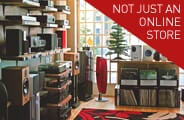Phono Stages - Musical Fidelity
The output level from a turntable is lower than other "line level" music sources (e.g. hi-fi streamer, CD player), so to use a turntable, your hi-fi amplifier needs to have a "turntable" or "phono" input, which indicates it has a built in phono stage. However, these are generally built to cost (a tick on the features list) rather than being optimised for performance. As such, we recommend using a dedicated phono stage for the best sound quality. We are passionate about vinyl and analog, so if you need advice on matching a phono stage to your turntable and cartridge, please call or e-mail for advice.
Musical Fidelity presents best-in-class quality hi-fi components conceived from over thirty years of audio expertise. They design and engineer impactful hi-fi separates hosting excellent sound, high technical performance, exceptional value for money and remarkable build quality.
Musical Fidelity has designed and manufactured Hi-Fi electronics for more than thirty years and are among the best-known brands in the Hi-Fi industry. They aim to deliver exceptional music and tackle the challenge of world-class engineering. Each new design approach seeks the absolute best solution and embraces cutting-edge technologies as well as refining traditional methods for better performance.
Founder Antony Michaelson designed and produced his first amplifier, The Preamp, for his own home as he was frustrated by the mediocre preamp in his audio system. It was heard by an audio dealer who placed an order for some and they were so successful that they all sold over their first weekend on display. Consequently and almost by accident, Musical Fidelity was launched in 1982 and The Preamp received glowing reviews. It was then followed by the shoebox-style Dr Thomas power amp.
Over almost four decades, Musical Fidelity has introduced an impressive line of products from the A1 integrated amp in 1984, A370 Power Amp and Digilog; the World’s first high-end DAC. Their technologies were always at the forefront of the industry; The MVX preamp was the first in the world to combine tube circuit topology with transistors, the SA470 power amp ran 99% in Class in 1988 which facilitated the release of the A1000 four years later featuring pure Class A power amp section.
The 90s saw in the classic valve-driven Tubalog DAC, X Series with X-10D Class A triode line stage, X-ACT DAC and X-24K upsampling DAC as well as the
X-Ray CD player. The Nu-Vista Preamp employing compact, metal-cased nuvistor tubes sold out within three months of launch in 1997. These formed the basis for upgraded models like the futuristic CD-PRE 24 combining a high-quality CD transport/DAC/preamp and the Nu-Vista M3 pre/power amp with discrete Nu-Vista power amp modules and choke regulation.
The Tri-Vista series offered the world’s first audio application of trivistor tubes and the kW 500 super integrated amp employed twin-triode tubes. In 2003, Musical Fidelity released their first turntable; the limited-edition M1 which was regarded as one of the best-engineered decks then went on to become a collector’s item fetching above its original price.
The supercharged X-DAC V8 introduced switchable tube buffer and extra-heavy-duty power supply and the brand won their first EISA award with the X-150 (2004-2005) for European Stereo Amplifier of the Year. KW250S packs in dual 250-watt monobloc amps, tube hybrid preamp, phono stage, 24-bit 192K upsampling CD player, FM/DAB tuner and iPod input.
Titan, launched in 2009, is a 1kW p/ch twin monobloc design with external power supply alongside the Reference-standard Primo pure Class A pre-amplifier with 14 hand-picked ECC81 tubes. Their most recent additions aim to satisfy all budgets and hi-fi needs. These include the EISA award-winnng M1 CLiC which brings together analogue and digital sources, their finest digital AMS CD/DAC and the world’s most advanced pure Class A amp; the AMS100.
Now owned by an Austria-based independent specialist Audio Tuning, the brand retains its proud British heritage and preserves the natural authentic audio performance that has become synonomous with Musical Fidelity across the world. The unique product series accommodate traditional and contemporary requirements from high quality vinyl listening, bit-perfect CD playback or increasingly popular wireless music streaming. For each source, Musical Fidelity supplies a broad range of powerful, state-of-the-art amplifiers that sound at home anywhere.
Some turntables feature an on board phono stage, which will allow for direct connection to an amplifier. Many amplifiers also include a “phono” amplifier internally, enabling a direct connection from a turntable. However, as mentioned, there is a wide range of separate standalone phono stages available, varying in price, size and quality to suit every taste and budget. Using a good quality separate unit can have a profound effect on the overall sound and tonality of your system, and can also be used to augment and adjust a system which is tonally too bright or too lacklustre. For example, a system which is too bright may benefit from a valve-based phono stage to remove some harshness and to offer more tonal warmth to your music. We appreciate that matching your kit can be a complicated and daunting process, so our knowledgeable team is always happy to offer recommendations or to arrange a demonstration.
The separation of components and units is a key technique in hi-fi. Power supplies are typically noisy and produce unwanted resonance, which can interfere with audio signals and the sound you achieve from your hi-fi. Separate pre and power amplifiers are preferable to integrated amplifiers, as the separation of power supplies for the pre and power circuitry prevents unwanted resonance effecting performance. This same logic applies to a standalone phono stage, and is perhaps even more significant due to the analogue nature of vinyl records, and the adverse effect that any unwanted resonance or vibrations can have on a cartridge’s ability to track and play back vinyl records. By housing the phono stage in a separate unit, the stage’s power supply is essentially isolated from the turntable, making it easier to prevent any undesired effects of resonance on you enjoying your record collection.
It is essential to match your phono stage to your phono cartridge, in order to ensure that they are compatible. Some Moving Coil (MC) cartridges are very low output, and so will need a correspondingly high output phono stage able to boost the signals to an audible level. There are also some High Output Moving Coil cartridges, whose output levels are closer to levels found in Moving Magnet cartridges, and higher than those typically found in standard Moving Coil cartridges. Some phono stages are suitable for use with these High Output cartridges, but not every type of Moving Coil cartridge. It is vital to check that your phono stage matches the power output of your cartridge, although if you have a Moving Magnet (MM) cartridge then there should be no issues with pairing.
























































































